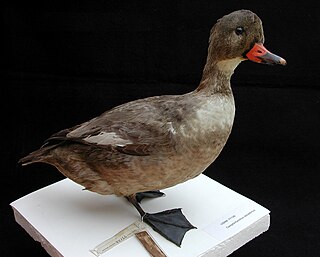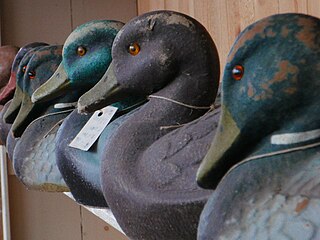
The Labrador duck is an extinct North American duck species. It has the distinction of being the first known endemic North American bird species to become extinct after the Columbian Exchange, with the last known sighting occurring in 1878 in Elmira, New York. It was already a rare duck before European settlers arrived, and as a result of its rarity, information on the Labrador duck is not abundant, although some, such as its habitat, characteristics, dietary habits and reasons behind its extinction, are known. There are 55 specimens of the Labrador duck preserved in museum collections worldwide.

Duck is the common name for numerous species of waterfowl in the family Anatidae. Ducks are generally smaller and shorter-necked than swans and geese, which are members of the same family. Divided among several subfamilies, they are a form taxon; they do not represent a monophyletic group, since swans and geese are not considered ducks. Ducks are mostly aquatic birds, and may be found in both fresh water and sea water.

WWT Arundel is one of ten wildfowl and wetland nature reserves managed by the Wildfowl and Wetlands Trust, a nature conservation charity in the United Kingdom. The 60 acres (24 ha) reserve is situated at the foot of the Offham Hangar, a part of the Arun valley in Arundel, West Sussex, England.

The Anatidae are the biological family of water birds that includes ducks, geese, and swans. The family has a cosmopolitan distribution, occurring on all the world's continents except Antarctica. These birds are adapted for swimming, floating on the water surface, and, in some cases, diving in at least shallow water. The family contains around 174 species in 43 genera.

The diving ducks, commonly called pochards or scaups, are a category of duck which feed by diving beneath the surface of the water. They are part of Anatidae, the diverse and very large family that includes ducks, geese, and swans.

The redhead is a medium-sized diving duck. The scientific name is derived from Greek aithuia, an unidentified seabird mentioned by authors including Hesychius and Aristotle, and Latin americana, of America. The redhead is 40–56 cm (16–22 in) long with an 74–84 cm (29–33 in) wingspan; the weight ranges from 1,030–1,080 g (36–38 oz), with males weighing an average of 1,080 g (38 oz) and females an average of 1,030 g (36 oz). It belongs to the genus Aythya, together with 11 other described species. The redhead and the common pochard form a sister group which together is sister to the canvasback. This waterfowl is easily distinguished from most other ducks by the male's copper colored head and pale blue bill during the breeding season; from its close relative canvasback it is distinguished by the more rounded head, shorter bill, and yellow, not red, eye. The Eurasian common pochard is even more similar, but very rarely overlaps in range; it also differs in having a red eye, and a more acute, less rounded head shape.

The greater scaup, just scaup in Europe or, colloquially, "bluebill" in North America, is a mid-sized diving duck, larger than the closely related lesser scaup and tufted duck. It spends the summer months breeding in Iceland, east across Scandinavia, northern Russia and Siberia, Alaska, and northern Canada. During the winter, it migrates south to the coasts of Europe, eastern Asia, and North America.

The lesser scaup is a small North American diving duck that migrates south as far as Central America in winter. It is colloquially known as the little bluebill or broadbill because of its distinctive blue bill. The origin of the name scaup may stem from the bird's preference for feeding on scalp—the Scottish word for clams, oysters, and mussels; however, some credit it to the female's discordant scaup call as the name's source. It is apparently a very close relative of the Holarctic greater scaup or "bluebill", with which it forms a superspecies. The scientific name is derived from Ancient Greek aithuia an unidentified seabird mentioned by authors including Hesychius and Aristotle, and Latin, affinis "related to", from its resemblance to the greater scaup.

The white-winged scoter is a large sea duck. The genus name is derived from Ancient Greek melas "black" and netta "duck". The species name commemorates French ornithologist Côme-Damien Degland.

The surf scoter is a large sea duck native to North America. Adult males are almost entirely black with characteristic white patches on the forehead and the nape and adult females are slightly smaller and browner. Surf scoters breed in Northern Canada and Alaska and winter along the Pacific and Atlantic coasts of North America. Those diving ducks mainly feed on benthic invertebrates, mussels representing an important part of their diet.

A decoy is usually a person, device, or event which resembles what an individual or a group might be looking for, but it is only meant to lure them. Decoys have been used for centuries most notably in game hunting, but also in wartime and in the committing or resolving of crimes.

Aythya is a genus of diving ducks, with twelve species currently accepted. The genus was described in 1822 by the German zoologist Friedrich Boie, with the type species being greater scaup. The name Aythya comes from the Ancient Greek word αἴθυιᾰ, which referred to an unknown diving-bird.

Mývatn is a shallow lake situated in an area of active volcanism in the north of Iceland, near Krafla volcano. It has a high amount of biological activity. The lake and the surrounding wetlands provides a habitat for a number of waterbirds, especially ducks. The lake was created by a large basaltic lava eruption 2300 years ago, and the surrounding landscape is dominated by volcanic landforms, including lava pillars and rootless vents (pseudocraters). The effluent river Laxá is known for its rich fishing for brown trout and Atlantic salmon.

A hunting blind (US), hide or machan is a concealment device or shelter for hunters or gamekeepers, designed to reduce the chance of detection by animals. There are different types of blinds for different situations, such as deer blinds and duck blinds. Some are exceedingly simple, while others are complex. The legality of various kinds of blinds may vary according to season, state and location.

Waterfowl hunting is the practice of hunting aquatic birds such as ducks, geese and other waterfowls or shorebirds for sport and meat. Waterfowl are hunted in crop fields where they feed, or in areas with bodies of water such as rivers, lakes, ponds, wetlands, sloughs, or coasts. There are around 3 million waterfowl hunters in the United States alone.

A sneakbox is a small boat that can be sailed, rowed, poled or sculled. It is predominantly associated with the Barnegat Bay in New Jersey, just as the canoe-like Delaware Ducker is associated with the New Jersey marshes along the Delaware River near Philadelphia.
A duck decoy is a man-made object resembling a duck. Duck decoys are typically used in waterfowl hunting to attract real ducks, but they are also used as collectible art pieces. Duck decoys were historically carved from wood, often Atlantic white cedar wood on the east coast of the United States, or cork. Modern ones may also be made of canvas and plastic. They are often painted to resemble various kinds of waterfowl.

Eastern Neck National Wildlife Refuge, a part of the Chesapeake Marshlands National Wildlife Refuge Complex, is a 2,286-acre (9.25 km2) island located at the confluence of the Chester River and the Chesapeake Bay. Established in 1962 as a sanctuary for migratory birds, Eastern Neck National Wildlife Refuge provides natural habitat for over 240 bird species — including bald eagles and transitory peregrine falcons — and is a major staging site for tundra swans.

Located in Coos County, New Hampshire, and Oxford County, Maine, Umbagog National Wildlife Refuge is a northern treasure in the National Wildlife Refuge System. The diversity of exceptional habitats provides excellent breeding and foraging areas for migratory birds, endangered species, resident wildlife, and rare plants. The refuge protects over 25,650 acres (103.8 km2) of wetland and forested upland habitat along Umbagog Lake. About 70% of its area is in New Hampshire and 30% in Maine.
The Sea Duck Joint Venture (SDJV) is a conservation partnership established in 1998 whose mission is "promoting the conservation of North America’s Sea Ducks". The partners are the Canadian Wildlife Service, the United States Fish and Wildlife Service, the United States Geological Survey, Ducks Unlimited, Bird Studies Canada, the Pacific Flyway Council, and the council for U.S. Flyways. It is one of three species joint ventures operating within the North American Waterfowl Management Plan.






















